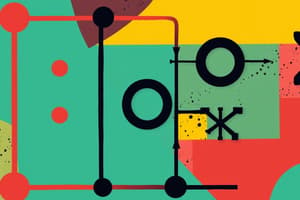Podcast
Questions and Answers
What does the symbol '∧' represent in symbolic logic?
What does the symbol '∧' represent in symbolic logic?
- It denotes a conjunction. (correct)
- It denotes negation.
- It denotes a disjunction.
- It denotes an implication.
Which of the following statements is true about the universal quantifier '∀'?
Which of the following statements is true about the universal quantifier '∀'?
- It indicates that a statement is true for all values of the variable. (correct)
- It cannot be used with propositional symbols.
- It is used exclusively with existential statements.
- It indicates the truth of a statement for at least one value within its domain.
In symbolic logic, what is the truth value of the statement 'p ∧ q' if p is true and q is false?
In symbolic logic, what is the truth value of the statement 'p ∧ q' if p is true and q is false?
- Both true and false
- False (correct)
- Indeterminate
- True
What is the role of truth tables in symbolic logic?
What is the role of truth tables in symbolic logic?
What conclusion can be drawn if both premises 'p and q' are true in the context of symbolic logic?
What conclusion can be drawn if both premises 'p and q' are true in the context of symbolic logic?
Which rule of inference states that if p is true and p implies q, then q is true?
Which rule of inference states that if p is true and p implies q, then q is true?
Which statement accurately describes well-formed formulas (WFFs)?
Which statement accurately describes well-formed formulas (WFFs)?
What does the symbol '¬' signify in symbolic logic?
What does the symbol '¬' signify in symbolic logic?
Flashcards
Propositional Symbol
Propositional Symbol
A symbol that represents a declarative statement, which can be either true or false.
Connective
Connective
A symbol that shows the relationship between propositional symbols to create a compound statement.
Conjunction
Conjunction
A logical connective (∧) that is true only if both parts are true.
Disjunction
Disjunction
Signup and view all the flashcards
Modus Ponens
Modus Ponens
Signup and view all the flashcards
Quantifier
Quantifier
Signup and view all the flashcards
Truth Table
Truth Table
Signup and view all the flashcards
Well-Formed Formula (WFF)
Well-Formed Formula (WFF)
Signup and view all the flashcards
Study Notes
Symbols in Symbolic Logic
- Symbolic logic uses symbols to represent statements and logical relationships. This allows for precise and unambiguous representation of arguments.
- Variables like "p," "q," and "r" often represent statements. Connectives like "∧" (and), "∨" (or), "→" (implies), and "¬" (not) denote logical operations.
- Quantifiers, such as ∀ (for all) and ∃ (there exists), specify the scope of variables in a statement.
Types of Symbols
- Propositional Symbols: Represent declarative statements (e.g., p: It is raining). These symbols can be true or false.
- Connectives: Show the relationships between propositional symbols, forming compound statements (e.g., p ∧ q: It is raining and the sun is shining, a conjunction).
- ∧ (conjunction): True only if both parts are true.
- ∨ (disjunction): True if at least one part is true.
- → (implication): False only if the antecedent (the "if" part) is true and the consequent (the "then" part) is false.
- ¬ (negation): Reverses the truth value of a statement.
- Quantifiers: Apply to variables representing individuals or sets.
- ∀ (universal quantifier): Indicates that a statement is true for all values of the variable within its specified domain. (e.g., ∀x, if x is a mammal, then x has lungs).
- ∃ (existential quantifier): Indicates that a statement is true for at least one value of the variable within its specified domain. (e.g. ∃y, y is a cat and y is black).
Truth Tables
- Truth tables are used to determine the truth value of a compound statement based on the truth values of its component statements.
Rules of Inference
- Rules of inference are logical operations, or steps, that are used to derive new conclusions based on premises or conditions.
- Modus Ponens: If p, then q. p is true. Therefore, q is true.
- Modus Tollens: If p, then q. q is false. Therefore, p is false.
- Hypothetical Syllogism: If p, then q. If q, then r. Therefore, if p, then r.
- Disjunctive Syllogism: p or q. p is false. Therefore, q is true.
- And Introduction: p and q are true. Therefore, p and q are true.
- And Elimination: p and q is true. Therefore p is true.
- Other Rules: Various other rules, such as Constructive Dilemma, exist to expand the logical possibilities for drawing inferences.
Well-Formed Formulas (WFFs)
- Well-formed formulas are properly constructed statements using propositional variables and connectives; following the syntax of symbolic logic rules.
Symbolic Representation of Arguments
- Arguments can be presented symbolically, replacing the statements with their symbols and the connectives with logical operators. This provides a clear and unambiguous representation of the structure of an argument, making it easier to analyze.
Applications
- Symbolic logic has widespread application in:
- Mathematics: Proving theorems and manipulating equations.
- Computer science: Designing computer programs and circuits, formal verification.
- Philosophy: Analyzing arguments, evaluating logical validity.
- Artificial intelligence: Representing knowledge and drawing inferences.
- Law: Constructing legal arguments and analyzing their logical consistency.
Studying That Suits You
Use AI to generate personalized quizzes and flashcards to suit your learning preferences.




